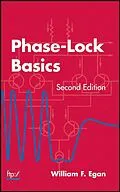Broad-based and hands-on, Phase-Lock Basics, Second Edition is both easy to understand and easy to customize. The text can be used as a theoretical introduction for graduate students or, when used with MATLAB simulation software, the book becomes a virtual laboratory for working professionals who want to improve their understanding of the design process and apply it to the demands of specific situations. This second edition features a large body of new statistical data obtained from simulations and uses available experimental data for confirmation of the simulation results.
Autorentext
William F. Egan, PhD, is Lecturer in Electrical Engineering at Santa Clara University, California, and formerly a principal engineer at TRW ESD and a senior technologist at GTE Government Systems. He received his PhD in electrical engineering from Stanford University.
Klappentext
A versatile and useful introduction to phase-locked loops—now in an updated edition
Phase-Lock Basics is a broad-based, hands-on text, designed to be both easy to understand and easy to customize. When used with MATLAB® simulation software, the book becomes a virtual laboratory for working professionals who want to improve their understanding of the design process and apply it to the demands of specific situations. The text can also be used as a theoretical introduction for graduate students. The description of second-order phase-locked loops is very thorough, covering all practical variations with formulas, graphs, worked examples, problem sets, and MATLAB® simulation exercises, which form a basis for understanding more complex loops. Features include:
-
Description of loop components, stability, responses,and performance in the presence of noise
-
MATLAB® simulation software and other design aids writtenexplicitly to correspond with the text
-
Access to an ftp site that corresponds with the textso that curves can be downloaded, duplicated, or modified
-
Scores of multicurve figures that illustrate various loop responses
-
A summary of acquisition formulas for second-order loops
-
Analysis and response curves for an important class of third-order loops
-
A four-page table of CW, AM, and FM signals in multiple representations
This Second Edition also includes new material on loop operation in noise, including a chapter on band-limited noise with MATLAB® scripts that enable the reader to duplicate and expand simulations. Phase-Lock Basics, Second Edition is an important reference for professional analog and digital circuit designers and also provides a complete and satisfying learning experience for graduate-level electrical engineering students.
Inhalt
Preface.
Symbols List and Glossary.
Getting Files from The Wiley Ftp Internet Site.
PART 1. PHASE LOCK WITHOUT NOISE.
1. INTRODUCTION.
1.1 What is a phase-locked loop (PLL)?.
1.2 Why use a phase-locked loop?.
1.3 Scope of This Book.
1.4 Basic Loop.
1.5 Phase Definitions.
1.6 Phase Detector.
1.7 Combined Gain.
1.8 Operating Range.
1.9 Units and the Laplace Variable s.
2. THE BASIC LOOP.
2.1 Steady-State Conditions.
2.2 Classical Analysis.
2.3 Mathematical Block Diagram.
2.4 Bode Plot.
2.5 Note on Phase Reversals.
2.6 Summary of Transient Responses of the First Order Loop.
3. LOOP COMPONENTS.
3.1 Phase Detector.
3.2 Voltage Controlled Oscillator (VCO).
3.3 Loop Filter.
3.3.3.2 Unintended Poles.
3.4 Filter Reference Voltage.
3.5 Note On the Form of the Filter Equation.
3.6 Capacitors in Loop Filters.
3.7 Higher-Order Filters.
4. LOOP RESPONSE .
4.1 Loop Order and Type.
4.2 Closed-Loop Equations.
4.3 Open-Loop Equations--Lag-Lead Filter.
4.4 Loop with a Lag Filter.
4.5 Loop With an Integrator-and-Lead Filter.
4.6 Summary of Equations.
5. LOOP STABILITY.
5.1 Observing the Open-Loop Response.
5.2 Methods of Stability Analysis and Measures of Stability.
5.3 Stability of Various PLL Configurations.
5.4 Computing Open-Loop Gain and Phase.
5.5 Phase Margin versus Damping Factor.
6. TRANSIENT RESPONSE.
6.1 Step Response.
6.2 Envelope of the Long-Term Step Response.
6.3 Response to Ramp Input.
6.4 Response to Parabolic Input.
6.5 Other Responses.
6.6 Note on Units for Graphs.
6.7 Equivalent Circuit.
6.8 General Long-Term (Steady-State) Response Characteristics.
6.9 Open-Loop Equations in Terms of Closed-Loop Parameters.
6.10 More Complex Loops and State Space Analysis.
6.11 An Approximate Solution Using State-Space Variables.
6.12 Effect of an Added Pole.
7. MODULATION RESPONSE.
7.1 Phase and Frequency Modulation.
7.2 Modulation Responses.
7.3 Responses in a First-Order Loop.
7.4 Transfer Functions in a Second-Order Loop.
7.5 Transient Responses Between Various Points.
7.6 Magnitude and Phase of the Transfer Functions.
7.7 Related Responses.
7.8 Modulation and Demodulation in the Second-Order Loop.
7.9 Measurement of Loop Parameters for α = 0 or 1 from Modulation Responses.
7.10 Effect of an Added Pole.
8. ACQUISITION.
8.1 Overview.
8.2 Acquisition and Lock In a First-Order Loop.
8.3 Acquisition Formulas For Second-Order Loops With Sine Phase Detectors.
8.4 Approximate Pull-In Analysis.
8.5 Phase Plane Analysis.
8.6 Pull Out.
8.7 Effect of Offsets.
8.8 Effect of Component Saturation.
8.9 Hang-up.
8.10 Simulation of the Nonlinear loop.
9. ACQUISITION AIDS.
9.1 Coherent Detection - Lock Indicator.
9.2 Changing Loop Parameters Temporarily.
9.3 Automatic Tuning of ωc --Frequency Discriminator.
9.4 Acquisition Aiding Logic.
9.5 Sweeping ωc, Type-2 Loop.
9.6 Sweep Circuits.
10. APPLICATIONS AND EXTENSIONS.
10.1 Higher Order Loops.
10.2 Generalized Voltage-Controlled Oscillator.
10.3 Long Loop.
10.4 Carrier Recovery.
10.5 Data Synchronization.
10.6 Clock an...
